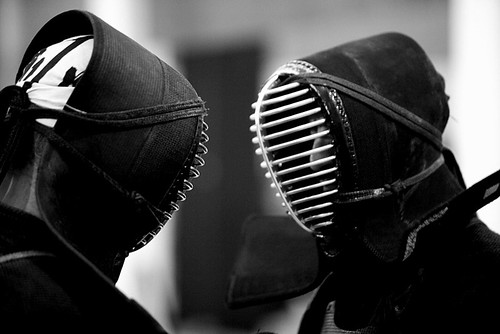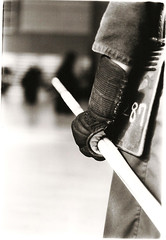By Robert Plotkin
 Most of my exposure to mindfulness has been through my study of martial arts. I was introduced to martial arts in, what I have learned, is a very common way: as a result of getting beaten up in the fifth grade. It was a typical way to get beaten up back then—another boy (who I’ll call John) thought I had slighted him at lunchtime while playing football, so he spread the word that he would fight me after school. As we exited the building at the end of the day, he called me out to fight, but I ignored him, so he tapped me on the shoulder from behind, and when I turned around he clocked me in the face.
Most of my exposure to mindfulness has been through my study of martial arts. I was introduced to martial arts in, what I have learned, is a very common way: as a result of getting beaten up in the fifth grade. It was a typical way to get beaten up back then—another boy (who I’ll call John) thought I had slighted him at lunchtime while playing football, so he spread the word that he would fight me after school. As we exited the building at the end of the day, he called me out to fight, but I ignored him, so he tapped me on the shoulder from behind, and when I turned around he clocked me in the face.
John hit me in the face several times. I have a vague memory of trying to hit back but I don’t actually remember whether I did or not. You might think that being hit in the face would be a great way to snap you into the present moment, and perhaps some people have that instinctive reaction, but I didn’t.
Fortunately, my old friend Teddy Kanokogi was nearby. Teddy was a tough kid from a tough family. To give you an idea of how tough his family was, his mother, Rusty Kanokogi, was a world-renowned judo master who won a men’s judo tournament disguised as a man in the 1950s and then ran a judo school in Flatbush for decades. Teddy’s father, Ryohei Kanokogi, was a karate master who gained fifteen minutes of fame in the U.S. for starring in a series of Samsonite luggage commercials where he tried, unsuccessfully, to beat a set of suitcases into submission.
Teddy saw what was happening and yelled “Hey!” at my attacker, John. John turned around, took one look at who had yelled, and then ran straight in the opposite direction. I snapped back to reality. Fortunately, I suffered only a black eye—at ten years old there is only so much damage you can do even when the other person doesn’t fight back.
Practitioners of mindfulness and the martial arts often speak of learning to respond rather than reacting. My reaction to being attacked shows one problem with reacting rather than responding. Reactions are automatic and based on whatever genetic hardwiring and/or past experience we happen to have. My reaction to being hit was a combination of confusion, fear, and flailing my arms around with my head turned away—not very productive. As my experience shows, reactions tend to have at least three components: mental, emotional, and physical. Since mental, emotional, and physical reactions are based on a combination of your nature and nurture, whether your reactions are helpful or harmful is outside of your control. Even if your reaction in a particular situation are productive, this is just luck and not something you can necessarily take credit for as the result of your wisdom or skill.
Those who have not studied the martial arts might find it surprising that learning to respond rather than react is one of the goals of martial arts training. That’s because you might think that the point of studying martial arts is to learn how to react as quickly as possible by decreasing your reaction time. After all, if you are training to defend yourself against expert armed attackers trying to kill you, don’t you need to learn to react as quickly as possible? Isn’t the purpose of “responding” to pause and develop a considered response to a situation rather than “reacting” immediately, and isn’t time the last thing a warrior has in battle?
Not necessarily. In fact, learning to respond rather than react is a necessity when you are battling highly skilled opponents.
 To illustrate this point, fast-forward 35 years after my schoolyard black eye. I am now a black belt in Shotokan karate; not a master but also no longer a beginner. My current sensei (teacher) of almost 20 years is back from Japan and teaching us techniques using the bo (a six-foot long wooden staff). He asks me to attack him so that he can demonstrate a particular technique for defending against an attack that is somewhat like swinging a baseball bat. I step up to the front of the class, face off against Sensei, and attack. I have been trained to attack with the full intention of landing a blow with all of my might, so I do so. As I am swinging the bo, I notice that Sensei is standing up straight, looking calm, his bo at his side. I can see and feel my bo approaching him, and I start to think, “Oh no! He is not going to block my attack on time. I’m going to hit him.” All of this is happening within the span of a second or two. My mind is racing and I am feeling anxious, but my training forces me to continue with everything I have.
To illustrate this point, fast-forward 35 years after my schoolyard black eye. I am now a black belt in Shotokan karate; not a master but also no longer a beginner. My current sensei (teacher) of almost 20 years is back from Japan and teaching us techniques using the bo (a six-foot long wooden staff). He asks me to attack him so that he can demonstrate a particular technique for defending against an attack that is somewhat like swinging a baseball bat. I step up to the front of the class, face off against Sensei, and attack. I have been trained to attack with the full intention of landing a blow with all of my might, so I do so. As I am swinging the bo, I notice that Sensei is standing up straight, looking calm, his bo at his side. I can see and feel my bo approaching him, and I start to think, “Oh no! He is not going to block my attack on time. I’m going to hit him.” All of this is happening within the span of a second or two. My mind is racing and I am feeling anxious, but my training forces me to continue with everything I have.
At the last moment, just before my bo is about to hit Sensei in the side, he turns sideways, raises his bo quickly but calmly, blocks my bo, and then counterattacks. The expression on his face never changes from a serene look that borders on boredom.
My next reaction is to feel embarrassed, not only because I had underestimated my teacher, but because he had taught me many times about the virtue of responding rather than reacting, and I had failed to absorb that lesson in the moment in two ways. First, I had reacted internally to what I falsely perceived to be my teacher’s lack of response. This caused my mind to wander from the present moment and instead to focus on thoughts about the present moment (“Am I about to hit Sensei?”). This left me unable to respond when Sensei blocked my attack and counterattack.
 Second, Sensei had specifically taught us many times that one of the ways to respond rather than react is to delay the timing of your block or evasion. Such a delay has many benefits, one of which is exactly what occurred that night – the attacker is taken by surprise by the defender’s apparent lack of response, and then taken by surprise again when the response occurs quickly and at the last possible moment. A real attacker may be lulled into a false sense of victory (“Yes! My attack is about to land!”), only to be taken by surprise by the delayed response of the defender, which leaves the attacker vulnerable to the defender’s counterattack while the attacker tries to regain his mental, physical, and emotional balance. So my second embarrassment was that I, as the attacker, had been taken by surprise even though I myself had been taught to use a delayed response. My problem was that I did not integrate that lesson deeply enough into my being at that moment.
Second, Sensei had specifically taught us many times that one of the ways to respond rather than react is to delay the timing of your block or evasion. Such a delay has many benefits, one of which is exactly what occurred that night – the attacker is taken by surprise by the defender’s apparent lack of response, and then taken by surprise again when the response occurs quickly and at the last possible moment. A real attacker may be lulled into a false sense of victory (“Yes! My attack is about to land!”), only to be taken by surprise by the delayed response of the defender, which leaves the attacker vulnerable to the defender’s counterattack while the attacker tries to regain his mental, physical, and emotional balance. So my second embarrassment was that I, as the attacker, had been taken by surprise even though I myself had been taught to use a delayed response. My problem was that I did not integrate that lesson deeply enough into my being at that moment.
Those who practice non-martial arts-based mindfulness may be more interested in the benefits of the delayed response to the defender. Put yourself in the shoes of my sensei, who stood calmly while I swung my bo at him. As far as I could tell, he did not react physically (flinching, grimacing, or even staring intensely), mentally (“How shall I block?”), or emotionally (fear, anger, pride) to my attack. Instead, he simply observed and experienced the attack coming at him. This ability to observe the attack without reacting provided the space in which he could respond in the time and manner of his choosing. For the particular technique he was teaching us, it was important to delay the timing of his response. More generally, however, in a real-life situation, someone who is capable of not reacting to an attack, but rather merely observing it, can create the space to freely choose how to respond, whether that be to block, move out of the way, kick the attacker’s shin and take the strength out of the attack, run away—or even to choose to be hit.
Although I have seen it written many times that the essence of responding rather than reacting is to “pause” or “take time” rather than reacting “immediately,” I think this gets at only part of the difference between reacting and responding. What makes it a response rather than a reaction is that: (1) you have not reacted to the attack, such as by moving, thinking, or feeling automatically based on your programming, and (2) you have freely and wisely chosen a response that is appropriate to the situation and your intentions.
If you have developed this ability to respond differently to the same or different stimuli (such as physical attacks) in different situations skillfully based on your wisdom, then you have truly learned the lesson of responding rather than reacting. Even if you respond immediately, you have not necessarily reacted; you may have just integrated your response into your being so fully that you are capable of responding without the need to delay for reflection. This is truly a very high level of mastery that I am far from attaining, although I feel myself fortunate even to have an inkling of what to strive for.
Robert Plotkin has been a student of martial arts, including the Shotokan, Shorin-Ryu, and Goju-Ryu styles of karate, for over 30 years. He earned his black belt under Sensei Nagao Matsuyama at the Doshi Kai dojo. He blogs on the intersection between science, technology, and mindfulness at TechnologyForMindfulness.com. Robert is on the Steering Committee of MIT Radius, where he has helped to create the “Hack Your Mind” program for bringing mindfulness practices to the MIT community. Robert lives in Barre, Massachusetts, in walking distance of the Insight Meditation Society.
Latest posts by Admin (see all)
- The Necessity of Mindfulness: Seeing Things as They Really Are - October 6, 2021
- How Mindfulness Saved My Life - August 8, 2021
- Mindfulness: A Bird’s-Eye View - July 11, 2021
Great article!
Maybe this can help:
https://www.researchgate.net/publication/279181274_MARTIAL_ARTS_MINDFUL_EXERCISE_TO_COMBAT_STRESS
Cheers,
Daniel
It is important to have a space between us and our emotions. This split is the beginning of starting managing emotions. Martial arts teach us in a critical situation how to keep that split active in the most difficult situations.
Cheers
Jason